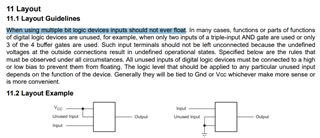Tool/software:
Hello experts,
My customer hopes to use SN74LVC1G17, however because they are designing 1 standardized board for several different models of refrigerator, for some models, they hope to keep the input floating.
For example, if they were to use total 3 ICs per board, they want to use 2 out of 3 for model A, all 3 for model B, only 1 for model C, etc. so this would leave them to leave 1 IC input floating for model A, etc.
In this case, I know the datasheet says to never design the input pin short..May I ask,
1. How does the output operate when input is left floating?
2. If input should never be left floating, could we maybe add a pull-down resistor to GND between the input pin and GND, and for the models that hopes to leave the input pin floating pull it down to GND? If the model does not leave the input pin floating we can simply not place the resistor on board and just leave the space for this..Would this affect the communication speed in any way?
Thank you in advance for your support.



